Antibody data
- Antibody Data
- Antigen structure
- References [25]
- Comments [0]
- Validations
- Flow cytometry [2]
- Other assay [4]
Submit
Validation data
Reference
Comment
Report error
- Product number
- 12-8888-42 - Provider product page

- Provider
- Invitrogen Antibodies
- Product name
- CD338 (ABCG2) Monoclonal Antibody (5D3), PE, eBioscience™
- Antibody type
- Monoclonal
- Antigen
- Other
- Description
- Description: The 5D3 monoclonal antibody reacts with the extracellular portion of the human ABCG2 protein, also known as Bcrp1 and MXR. The ABCG2 gene, a member of the multi-drug resistance (MDR) family, is highly expressed on primitive 'side-population' (SP) stem cells, which are defined by the efflux of fluorescent dyes such as Rhodamine 123 and Hoechest 33342. In the bone marrow, about 0.05% of cells display the low fluorescence and are highly enriched for repopulating cells. The SP cells, which express low or undetectable levels of CD34, have been identified in multiple species. In addition, expression of ABCG2 appears to be highly conserved. Applications Reported:The 5D3 antibody has been reported for use in flow cytometric analysis. Applications Tested: Has been pre-titrated and tested by flow cytometric analysis of ABCG2 transfected cells and peripheral blood cells. This can be used at 5 µL (0.25 µg) per test. A test is defined as the amount (µg) of antibody that will stain a cell sample in a final volume of 100 µL. Cell number should be determined empirically but can range from 10^5 to 10^8 cells/test. A test is defined as the amount (µg) of antibody that will stain a cell sample in a final volume of 100 µL. Cell number should be determined empirically but can range from 10^5 to 10^8 cells/test. It is recommended that the antibody be carefully titrated for optimal performance in the assay of interest. Excitation: 488-561 nm; Emission: 578 nm; Laser: Blue Laser, Green Laser, Yellow-Green Laser. Filtration: 0.2 µm post-manufacturing filtered.
- Reactivity
- Human
- Host
- Mouse
- Conjugate
- Yellow dye
- Isotype
- IgG
- Antibody clone number
- 5D3
- Vial size
- 100 Tests
- Concentration
- 5 μL/Test
- Storage
- 4°C, store in dark, DO NOT FREEZE!
Submitted references Engineering Escherichia coli for diagnosis and management of hyperuricemia.
CBP-mediated Wnt3a/β-catenin signaling promotes cervical oncogenesis initiated by Piwil2.
Piwil2 is reactivated by HPV oncoproteins and initiates cell reprogramming via epigenetic regulation during cervical cancer tumorigenesis.
Tariquidar Is an Inhibitor and Not a Substrate of Human and Mouse P-glycoprotein.
Using the BacMam Baculovirus System to Study Expression and Function of Recombinant Efflux Drug Transporters in Polarized Epithelial Cell Monolayers.
A double blinded, placebo-controlled pilot study to examine reduction of CD34 (+)/CD117 (+)/CD133 (+) lymphoma progenitor cells and duration of remission induced by neoadjuvant valspodar in dogs with large B-cell lymphoma.
Canine osteosarcoma cells exhibit resistance to aurora kinase inhibitors.
Lysosomal drug sequestration as a mechanism of drug resistance in vascular sarcoma cells marked by high CSF-1R expression.
ABCG2pos lung mesenchymal stem cells are a novel pericyte subpopulation that contributes to fibrotic remodeling.
Human prostate side population cells demonstrate stem cell properties in recombination with urogenital sinus mesenchyme.
Transcription factors Sp1 and Sp3 regulate expression of human ABCG2 gene and chemoresistance phenotype.
Targeting the ABCG2-overexpressing multidrug resistant (MDR) cancer cells by PPARγ agonists.
Ethyl 2-amino-6-(3,5-dimethoxyphenyl)-4-(2-ethoxy-2-oxoethyl)-4H-chromene-3-carboxylate (CXL017): a novel scaffold that resensitizes multidrug resistant leukemia cells to chemotherapy.
Adverse Cell Culture Conditions Mimicking the Tumor Microenvironment Upregulate ABCG2 to Mediate Multidrug Resistance and a More Malignant Phenotype.
Regulation and expression of the ATP-binding cassette transporter ABCG2 in human embryonic stem cells.
Surface antigenic profiling of stem cells from human omentum fat in comparison with subcutaneous fat and bone marrow.
New use for an old drug: inhibiting ABCG2 with sorafenib.
Identification of proline residues in or near the transmembrane helices of the human breast cancer resistance protein (BCRP/ABCG2) that are important for transport activity and substrate specificity.
Structure and function of ABCG2-rich extracellular vesicles mediating multidrug resistance.
Transmembrane helices 1 and 6 of the human breast cancer resistance protein (BCRP/ABCG2): identification of polar residues important for drug transport.
Role of basic residues within or near the predicted transmembrane helix 2 of the human breast cancer resistance protein in drug transport.
Structural determinants of imidazoacridinones facilitating antitumor activity are crucial for substrate recognition by ABCG2.
Arginine 383 is a crucial residue in ABCG2 biogenesis.
Becatecarin (rebeccamycin analog, NSC 655649) is a transport substrate and induces expression of the ATP-binding cassette transporter, ABCG2, in lung carcinoma cells.
Identification of cancer stem cell-like side population cells in human nasopharyngeal carcinoma cell line.
Gencer G, Mancuso C, Chua KJ, Ling H, Costello CM, Chang MW, March JC
Frontiers in bioengineering and biotechnology 2023;11:1191162
Frontiers in bioengineering and biotechnology 2023;11:1191162
CBP-mediated Wnt3a/β-catenin signaling promotes cervical oncogenesis initiated by Piwil2.
Feng D, Yan K, Liang H, Liang J, Wang W, Yu H, Zhou Y, Zhao W, Dong Z, Ling B
Neoplasia (New York, N.Y.) 2021 Jan;23(1):1-11
Neoplasia (New York, N.Y.) 2021 Jan;23(1):1-11
Piwil2 is reactivated by HPV oncoproteins and initiates cell reprogramming via epigenetic regulation during cervical cancer tumorigenesis.
Feng D, Yan K, Zhou Y, Liang H, Liang J, Zhao W, Dong Z, Ling B
Oncotarget 2016 Oct 4;7(40):64575-64588
Oncotarget 2016 Oct 4;7(40):64575-64588
Tariquidar Is an Inhibitor and Not a Substrate of Human and Mouse P-glycoprotein.
Weidner LD, Fung KL, Kannan P, Moen JK, Kumar JS, Mulder J, Innis RB, Gottesman MM, Hall MD
Drug metabolism and disposition: the biological fate of chemicals 2016 Feb;44(2):275-82
Drug metabolism and disposition: the biological fate of chemicals 2016 Feb;44(2):275-82
Using the BacMam Baculovirus System to Study Expression and Function of Recombinant Efflux Drug Transporters in Polarized Epithelial Cell Monolayers.
Fung KL, Kapoor K, Pixley JN, Talbert DJ, Kwit AD, Ambudkar SV, Gottesman MM
Drug metabolism and disposition: the biological fate of chemicals 2016 Feb;44(2):180-8
Drug metabolism and disposition: the biological fate of chemicals 2016 Feb;44(2):180-8
A double blinded, placebo-controlled pilot study to examine reduction of CD34 (+)/CD117 (+)/CD133 (+) lymphoma progenitor cells and duration of remission induced by neoadjuvant valspodar in dogs with large B-cell lymphoma.
Ito D, Childress M, Mason N, Winter A, O'Brien T, Henson M, Borgatti A, Lewellen M, Krick E, Stewart J, Lahrman S, Rajwa B, Scott MC, Seelig D, Koopmeiners J, Ruetz S, Modiano J
F1000Research 2015;4:42
F1000Research 2015;4:42
Canine osteosarcoma cells exhibit resistance to aurora kinase inhibitors.
Cannon CM, Pozniak J, Scott MC, Ito D, Gorden BH, Graef AJ, Modiano JF
Veterinary and comparative oncology 2015 Mar;13(1):48-59
Veterinary and comparative oncology 2015 Mar;13(1):48-59
Lysosomal drug sequestration as a mechanism of drug resistance in vascular sarcoma cells marked by high CSF-1R expression.
Gorden BH, Saha J, Khammanivong A, Schwartz GK, Dickerson EB
Vascular cell 2014;6:20
Vascular cell 2014;6:20
ABCG2pos lung mesenchymal stem cells are a novel pericyte subpopulation that contributes to fibrotic remodeling.
Marriott S, Baskir RS, Gaskill C, Menon S, Carrier EJ, Williams J, Talati M, Helm K, Alford CE, Kropski JA, Loyd J, Wheeler L, Johnson J, Austin E, Nozik-Grayck E, Meyrick B, West JD, Klemm DJ, Majka SM
American journal of physiology. Cell physiology 2014 Oct 15;307(8):C684-98
American journal of physiology. Cell physiology 2014 Oct 15;307(8):C684-98
Human prostate side population cells demonstrate stem cell properties in recombination with urogenital sinus mesenchyme.
Foster BA, Gangavarapu KJ, Mathew G, Azabdaftari G, Morrison CD, Miller A, Huss WJ
PloS one 2013;8(1):e55062
PloS one 2013;8(1):e55062
Transcription factors Sp1 and Sp3 regulate expression of human ABCG2 gene and chemoresistance phenotype.
Yang WJ, Song MJ, Park EY, Lee JJ, Park JH, Park K, Park JH, Kim HP
Molecules and cells 2013 Oct;36(4):368-75
Molecules and cells 2013 Oct;36(4):368-75
Targeting the ABCG2-overexpressing multidrug resistant (MDR) cancer cells by PPARγ agonists.
To KK, Tomlinson B
British journal of pharmacology 2013 Nov;170(5):1137-51
British journal of pharmacology 2013 Nov;170(5):1137-51
Ethyl 2-amino-6-(3,5-dimethoxyphenyl)-4-(2-ethoxy-2-oxoethyl)-4H-chromene-3-carboxylate (CXL017): a novel scaffold that resensitizes multidrug resistant leukemia cells to chemotherapy.
Das SG, Hermanson DL, Bleeker N, Lowman X, Li Y, Kelekar A, Xing C
ACS chemical biology 2013 Feb 15;8(2):327-35
ACS chemical biology 2013 Feb 15;8(2):327-35
Adverse Cell Culture Conditions Mimicking the Tumor Microenvironment Upregulate ABCG2 to Mediate Multidrug Resistance and a More Malignant Phenotype.
Cheng GM, To KK
ISRN oncology 2012;2012:746025
ISRN oncology 2012;2012:746025
Regulation and expression of the ATP-binding cassette transporter ABCG2 in human embryonic stem cells.
Padmanabhan R, Chen KG, Gillet JP, Handley M, Mallon BS, Hamilton RS, Park K, Varma S, Mehaffey MG, Robey PG, McKay RD, Gottesman MM
Stem cells (Dayton, Ohio) 2012 Oct;30(10):2175-87
Stem cells (Dayton, Ohio) 2012 Oct;30(10):2175-87
Surface antigenic profiling of stem cells from human omentum fat in comparison with subcutaneous fat and bone marrow.
Dhanasekaran M, Indumathi S, Kanmani A, Poojitha R, Revathy KM, Rajkumar JS, Sudarsanam D
Cytotechnology 2012 Feb 1;64(5):497-509
Cytotechnology 2012 Feb 1;64(5):497-509
New use for an old drug: inhibiting ABCG2 with sorafenib.
Wei Y, Ma Y, Zhao Q, Ren Z, Li Y, Hou T, Peng H
Molecular cancer therapeutics 2012 Aug;11(8):1693-702
Molecular cancer therapeutics 2012 Aug;11(8):1693-702
Identification of proline residues in or near the transmembrane helices of the human breast cancer resistance protein (BCRP/ABCG2) that are important for transport activity and substrate specificity.
Ni Z, Bikadi Z, Shuster DL, Zhao C, Rosenberg MF, Mao Q
Biochemistry 2011 Sep 20;50(37):8057-66
Biochemistry 2011 Sep 20;50(37):8057-66
Structure and function of ABCG2-rich extracellular vesicles mediating multidrug resistance.
Goler-Baron V, Assaraf YG
PloS one 2011 Jan 24;6(1):e16007
PloS one 2011 Jan 24;6(1):e16007
Transmembrane helices 1 and 6 of the human breast cancer resistance protein (BCRP/ABCG2): identification of polar residues important for drug transport.
Ni Z, Bikadi Z, Cai X, Rosenberg MF, Mao Q
American journal of physiology. Cell physiology 2010 Nov;299(5):C1100-9
American journal of physiology. Cell physiology 2010 Nov;299(5):C1100-9
Role of basic residues within or near the predicted transmembrane helix 2 of the human breast cancer resistance protein in drug transport.
Cai X, Bikadi Z, Ni Z, Lee EW, Wang H, Rosenberg MF, Mao Q
The Journal of pharmacology and experimental therapeutics 2010 Jun;333(3):670-81
The Journal of pharmacology and experimental therapeutics 2010 Jun;333(3):670-81
Structural determinants of imidazoacridinones facilitating antitumor activity are crucial for substrate recognition by ABCG2.
Bram EE, Adar Y, Mesika N, Sabisz M, Skladanowski A, Assaraf YG
Molecular pharmacology 2009 May;75(5):1149-59
Molecular pharmacology 2009 May;75(5):1149-59
Arginine 383 is a crucial residue in ABCG2 biogenesis.
Polgar O, Ediriwickrema LS, Robey RW, Sharma A, Hegde RS, Li Y, Xia D, Ward Y, Dean M, Ozvegy-Laczka C, Sarkadi B, Bates SE
Biochimica et biophysica acta 2009 Jul;1788(7):1434-43
Biochimica et biophysica acta 2009 Jul;1788(7):1434-43
Becatecarin (rebeccamycin analog, NSC 655649) is a transport substrate and induces expression of the ATP-binding cassette transporter, ABCG2, in lung carcinoma cells.
Robey RW, Obrzut T, Shukla S, Polgar O, Macalou S, Bahr JC, Di Pietro A, Ambudkar SV, Bates SE
Cancer chemotherapy and pharmacology 2009 Aug;64(3):575-83
Cancer chemotherapy and pharmacology 2009 Aug;64(3):575-83
Identification of cancer stem cell-like side population cells in human nasopharyngeal carcinoma cell line.
Wang J, Guo LP, Chen LZ, Zeng YX, Lu SH
Cancer research 2007 Apr 15;67(8):3716-24
Cancer research 2007 Apr 15;67(8):3716-24
No comments: Submit comment
Supportive validation
- Submitted by
- Invitrogen Antibodies (provider)
- Main image
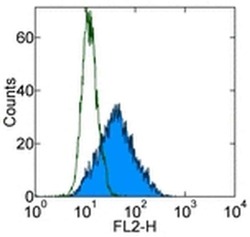
- Experimental details
- Staining of human CD338-transfected cells with Mouse IgG2b K Isotype Control PE (Product # 12-4732-81) (open histogram) or Anti-Human CD338 (ABCG2) PE (filled histogram). Total viable cells were used for analysis.
- Conjugate
- Yellow dye
- Submitted by
- Invitrogen Antibodies (provider)
- Main image
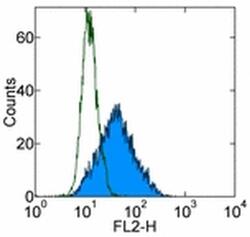
- Experimental details
- Staining of human CD338-transfected cells with Mouse IgG2b K Isotype Control PE (Product # 12-4732-81) (open histogram) or Anti-Human CD338 (ABCG2) PE (filled histogram). Total viable cells were used for analysis.
Supportive validation
- Submitted by
- Invitrogen Antibodies (provider)
- Main image
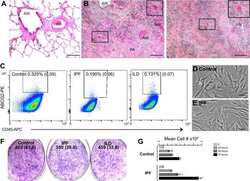
- Experimental details
- NULL
- Conjugate
- Yellow dye
- Submitted by
- Invitrogen Antibodies (provider)
- Main image
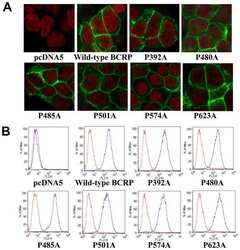
- Experimental details
- NULL
- Conjugate
- Yellow dye
- Submitted by
- Invitrogen Antibodies (provider)
- Main image
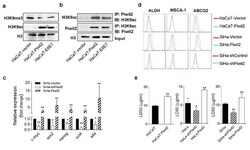
- Experimental details
- Figure 7 Piwil2 initiates cell reprogramming by regulating the balance between the acetylation and trimethylation of H3K9 a. Western blot showing significantly induced H3K9 acetylation but reduced H3K9 trimethylation in HaCaT cells transfected with Piwil2 or E6 and E7 compared with those only transfected with vector. b. Co-immunoprecipitation showing that Piwil2, either overexpressed or induced by E6 and E7, interacted with acetylated H3K9. c. EMT markers upregulated in SiHa cells exhibiting Piwil2 overexpression but downregulated in those cells in which Piwil2 was knocked down, as verified by qRT-PCR. d. The proportion of ALDH-, MSCA-1-, and ABCG2-positive cells, determined by FACS in cells with Piwil2 overexpression or knockdown. e. The LD50 dose of cisplatin, detected by CCK8 assay in cells with Piwil2 overexpression or knockdown. The data are presented as the mean+-SD. * P < 0.05 and ** P < 0.01 by Student's t -test.
- Conjugate
- Yellow dye
- Submitted by
- Invitrogen Antibodies (provider)
- Main image
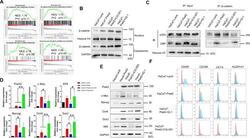
- Experimental details
- Figure 4 CBP/beta-catenin promotes the maintenance of stem cell reprogramming by Piwil2. (A) GSEA plot showing significant enrichment of the Wnt/beta-catenin signaling activation modules in HaCaT-Piwil2 cells. (B) Immunoblotting of beta-catenin translocated into the nucleus in HaCaT-Piwil2 cells after treatment with 20 uM ICG-001 or IQ-1 for 24 h. (C) Nuclear lysates from HaCaT-Piwil2 cells treated with 20 uM ICG-001, 20 uM IQ-1, or DMSO were coimmunoprecipitated with antisera to beta-catenin and immunoblotted for CBP and p300. (D and E) The expression of Piwil2 and the ""reprogramming"" factors c-Myc, Nanog, Oct4, Sox2 , and Klf4 was determined by real-time PCR and immunoblotting in HaCaT-Piwil2 cells treated with 20 uM ICG-001, 20 uM IQ-1, or DMSO for 24 h. (F) The proportion of CD49f-, CD338-, OCT4-, and ALDHA1-positive cells, determined by flow cytometry in HaCaT-Piwil2 cells treated with 20 uM ICG-001, 20 uM IQ-1, or DMSO for 24 h. The data are presented as the mean +- SD. * P < 0.05 and ** P < 0.01 by Student's t test. Figure 4
- Conjugate
- Yellow dye
 Explore
Explore Validate
Validate Learn
Learn Flow cytometry
Flow cytometry